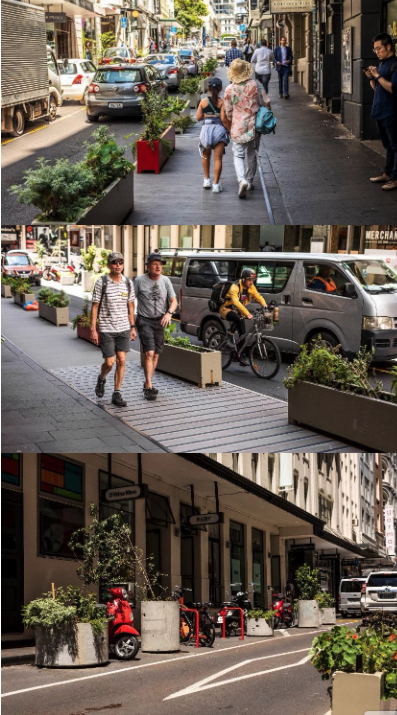Award
Facilities or place-making
Winner
Auckland Design Office, Auckland City Council
In brief
As part of the overarching Access for Everyone project, the High Street Trial aimed to allocate more space to pedestrians and other users, by replacing on-street parking with temporary kerb/footpath extensions, to effectively double the width of this street’s narrow footpaths.
It received outstanding public and political support which will support future pedestrian initiatives.
The detail
(From the nomination form.)
 Motivation for the initiative
Motivation for the initiative
This initiative was motivated by a wider programme for central Auckland, called “Access for Everyone” (A4E). Access for Everyone is a bold new strategy for Auckland’s Central City, developed by MRCagney for the Auckland Design Office, part of Auckland Council. It reshapes the transport circulation, street design and operations to re-allocate space in the city and to move the balance away from private vehicles and toward more efficient uses. Under Access for Everyone, space is allocated to public transport, walking, cycling and general public use, while also reducing vehicle emissions towards a zero emissions area in the city centre.
As part of the overarching Access for Everyone project, the High Street Trial aimed to allocate more space to pedestrians and other users, by replacing on-street parking with temporary kerb/footpath extensions, to effectively double the width of this street’s narrow footpaths. High Street runs parallel to Queen Street and is made up of small businesses in heritage buildings at the ground level, lending a boutique feel to the area. Two laneways (Vulcan Lane and Durham Lane) run between High Street and Queen Street, both of which are pedestrianised. The street has generally been associated with narrow footpaths and pedestrian overcrowding, especially during peak commuting times and at lunch times. Drivers cruising for parking and congestion along the road would also cause blockages for vehicles on the street, in some cases preventing access for emergency vehicles.
Barriers to the project included concerns from retailers and other businesses. Historically, attempts to remove parking along High Street have been opposed by local businesses, out of fear of negative economic repercussions.
Auckland Design Office and Auckland Council implemented the High Street trial as a pilot programme to demonstrate the practicality and benefits of reallocating space to pedestrians in line with Access to Everyone.
Coverage, people affected
The City Centre of Auckland has a living population of 35,000 (Stats NZ 2018). This fluctuates significantly with the arrival of up to 115,000 workers each day. The daily population includes workers, students, residents and daily visitors with an estimated 500,000 weekday internal walking trips on the city streets. As well as the permanent population, 2.5 million international visitors come to the city centre each year. High Street is a laneway with heavy use by both workers and shoppers, a percentage of those daily walking trips.
Initial surveys of pedestrian activity on High Street suggested there were 13 times as many people using the street on foot as there were in vehicles, while 68% of space was allocated to vehicles and parking.
Census data shows that 24% of New Zealand’s population lives with a permanent disability, and approximately 3% of all people use a mobility aid (such as a walking stick or wheelchair) when out and about.
Recent manual pedestrian counts in central Auckland by MRCagney showed that less than 0.5% of pedestrians on High Street, Victoria Street West, Grafton Gully, and Grafton Bridge use a mobility aid. These data suggest that there is massive room for improvement in inclusive access to and within central Auckland.
Success to date
The project was funded and championed by the Auckland Design Office, part of Auckland Council. It was acknowledged as being very successful, by local retailers and residents, pedestrians, and is now more widely recognised as a key component of future social distancing measures.
Media clips demonstrate the positive feedback around the project. The project was fully funded by Auckland Council and Auckland Transport. To quote the Auckland Design Office, “People are the economic power house of the City… These projects focus on building a pedestrian haven for downtown which will enliven the city for everyone”. Clips also show more recent coverage of the footpath extensions as a key consideration for communities in a COVID-19 influenced world.
Applicability of this initiative to other locations or organisations
As can be seen in recent media, the High Street Trial is being used to demonstrate how other councils and regions can quickly and easily install footpath extensions in the Covid-19 social distancing world. While initially seen as being mostly applicable to the central Auckland laneway network, the design is being used as a demonstration across New Zealand for how to enable much easier movement of pedestrians in the future, and a rapid response and solution for Covid-19 and other emergency situations.
A number of key stakeholders were concerned that partial pedestrianisation and removal of traffic from the City Centre laneways “wouldn’t work”. In order to prove that the concept could be successful, the High Street project was delivered as a trial through a co-design and collaboration with the community who live, work and use the street. Framing this project as a trial, and implementing with easily removable structures was in itself an innovative approach. High Street was proposed as the first in a series of trials, allowing the city to “test” the redistribution of space in the city.
Radio NZ video interview on transformation of High Street
